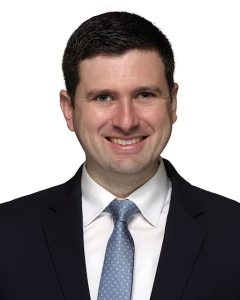 Back pain is among the more common conditions routinely seen in rheumatology practice, and the differential related to this and other spinal symptoms can be broad. Frequently, involving a spine specialist is of help in terms of a patient’s diagnosis and management. Jay Reidler, MD, MPH, is an adult and pediatric orthopedic spine surgeon with training that includes an adult and pediatric spine surgery fellowship at Och Spine New York-Presbyterian Hospital/Columbia University, a complex pediatric spine surgery fellowship at Shriners Hospital for Children, Philadelphia, and training in minimally invasive techniques for complex adult spinal conditions at the University of Pennsylvania.
Back pain is among the more common conditions routinely seen in rheumatology practice, and the differential related to this and other spinal symptoms can be broad. Frequently, involving a spine specialist is of help in terms of a patient’s diagnosis and management. Jay Reidler, MD, MPH, is an adult and pediatric orthopedic spine surgeon with training that includes an adult and pediatric spine surgery fellowship at Och Spine New York-Presbyterian Hospital/Columbia University, a complex pediatric spine surgery fellowship at Shriners Hospital for Children, Philadelphia, and training in minimally invasive techniques for complex adult spinal conditions at the University of Pennsylvania.
Dr. Reidler sat down with The Rheumatologist (TR) to discuss his insights on spinal care and his collaboration with rheumatologists.
TR: What are some similarities and differences in the training for, and the conditions treated by, orthopedic vs. neurosurgical spinal surgeons?
Dr. Reidler: There are two paths to becoming a spinal surgeon: one that begins with an orthopedics residency and one that is via a neurosurgery residency. For the orthopedist, a spine fellowship after residency is required, and this will focus entirely on spinal cases (as opposed to training for a neurosurgeon, which will include cases involving the brain and may or may not involve fellowship training beyond residency). Both types of surgeons may see many of the same conditions in clinical practice, and there is often an opportunity to train together (many of the fellowships that I completed were joint orthopedic/neurosurgical programs).
If there is an intra-dural process, this will fall in the purview of a neurosurgical spinal surgeon. All extra-dural spinal cases can be seen by either an orthopedic spine surgeon or a neurosurgical spine surgeon, and cases commonly seen by orthopedic spine surgeons include those involving spinal deformities, spondylolisthesis, and other structural issues. Orthopedic spine surgeons also may see more pediatric patients than do neurosurgical spine surgeons.
TR: What are the most common referrals you tend to receive from rheumatologists?
 Dr. Reidler: I often see patients referred for disc herniation, spinal stenosis, lumbar or cervical radiculopathy and scoliosis. I certainly collaborate with rheumatologists on challenging cases that may include inflammatory arthritides that involve the axial spine. For instance, I see a number of patients with spondyloarthritis, including radiographic and non-radiographic axial spondyloarthritis. I also see patients with cervical instability from a variety of causes, particularly patients with rheumatoid arthritis.
Dr. Reidler: I often see patients referred for disc herniation, spinal stenosis, lumbar or cervical radiculopathy and scoliosis. I certainly collaborate with rheumatologists on challenging cases that may include inflammatory arthritides that involve the axial spine. For instance, I see a number of patients with spondyloarthritis, including radiographic and non-radiographic axial spondyloarthritis. I also see patients with cervical instability from a variety of causes, particularly patients with rheumatoid arthritis.
TR: When you evaluate if a patient would likely have success with a surgical intervention, what factors do you consider important?
Dr. Reidler: To have a good surgical outcome, several arrows must intersect with one another. For example, the patient’s symptoms should be concordant with the physical exam, and both the physical exam and the history should match the imaging findings. If these items align, I will typically feel that I have the right diagnosis for the patient.
Once the right diagnosis is found, the right procedure must be selected. This includes determining if the procedure will be less or more invasive and which technique ought to be applied. For example, if a patient needs a fusion but you only perform a decompression, then this patient may require a second surgery. If a decompression would have sufficed instead of a fusion, then the healing process may be needlessly longer and more complex.
The third element of importance is the surgeon themself: Do they have the skills and experience necessary to perform the selected procedure?
Finally, the patient’s biology and comorbidities must be considered, including their age, past surgical history, risk of infection and so forth.
In general, if there is a focal neurologic deficit and the etiology of this deficit can be identified, this portends a high chance of success with surgical intervention. Patients with nerve impingement and spinal stenosis with claudication symptoms will typically respond well to surgery. If, on the other hand, symptoms are vague and generalized, then surgery may not necessarily be the best option.
TR: Can you discuss a few important concepts that rheumatologists should know about with regard to the management of chronic back pain in their patients?
Dr. Reidler: My first inclination is always to think about nonsurgical approaches for the management of back pain. This can often involve physical therapy, weight loss and outpatient procedures like epidural injections when indicated. It may be helpful to involve a spinal surgeon in the care of these patients because there are different degrees of spinal degeneration and the radiology report may not tell the whole story on its own. I like to look at all imaging studies myself and interpret these studies in the clinical context. A patient may have had 20 years of back pain and only have one spinal level with severe degenerative changes that are amenable to intervention. In contrast, a patient with multilevel changes is unlikely to improve with one surgical intervention alone.
When I work together with rheumatologists, I convey to them the importance of ensuring that the underlying autoimmune condition is under adequate control by the time of surgery. Surgeons may sometimes be eager to operate when they see a focal finding that would typically respond to surgery, but if the underlying inflammatory arthritis is not well controlled when the patient goes to the OR, then the results are likely to be poor.
TR: What are the most exciting recent developments in your field that you would like to share with readers?
Dr. Reidler: There now exists technology that utilizes advanced algorithms and state-of-the-art 3D modeling to develop personalized surgical plans and spinal implant devices. For many years, surgeons have relied on selecting off-the-shelf surgical implants for patients, like picking a shoe at the shoe store based on the available sizes. With this newer technology, we can provide care that is individualized to the patient’s anatomy. This is important in the treatment of patients with conditions like axial spondyloarthritis, when the vertebral body endplates can become distorted and irregular and the typical surgical implants will not fit well.
The other area that I am excited about is the use of robotic surgery, which is often more precise, more predictable and less invasive than conventional techniques. For instance, screw accuracy is now much higher than it used to be and we are able to operate with smaller incisions than was possible in the past. I feel fortunate to have trained with these techniques and to be practicing in an era of advanced technological capabilities in the surgical realm.
 Jason Liebowitz, MD, FACR, is an assistant professor of medicine in the Division of Rheumatology at Columbia University Vagelos College of Physicians and Surgeons, New York.
Jason Liebowitz, MD, FACR, is an assistant professor of medicine in the Division of Rheumatology at Columbia University Vagelos College of Physicians and Surgeons, New York.

